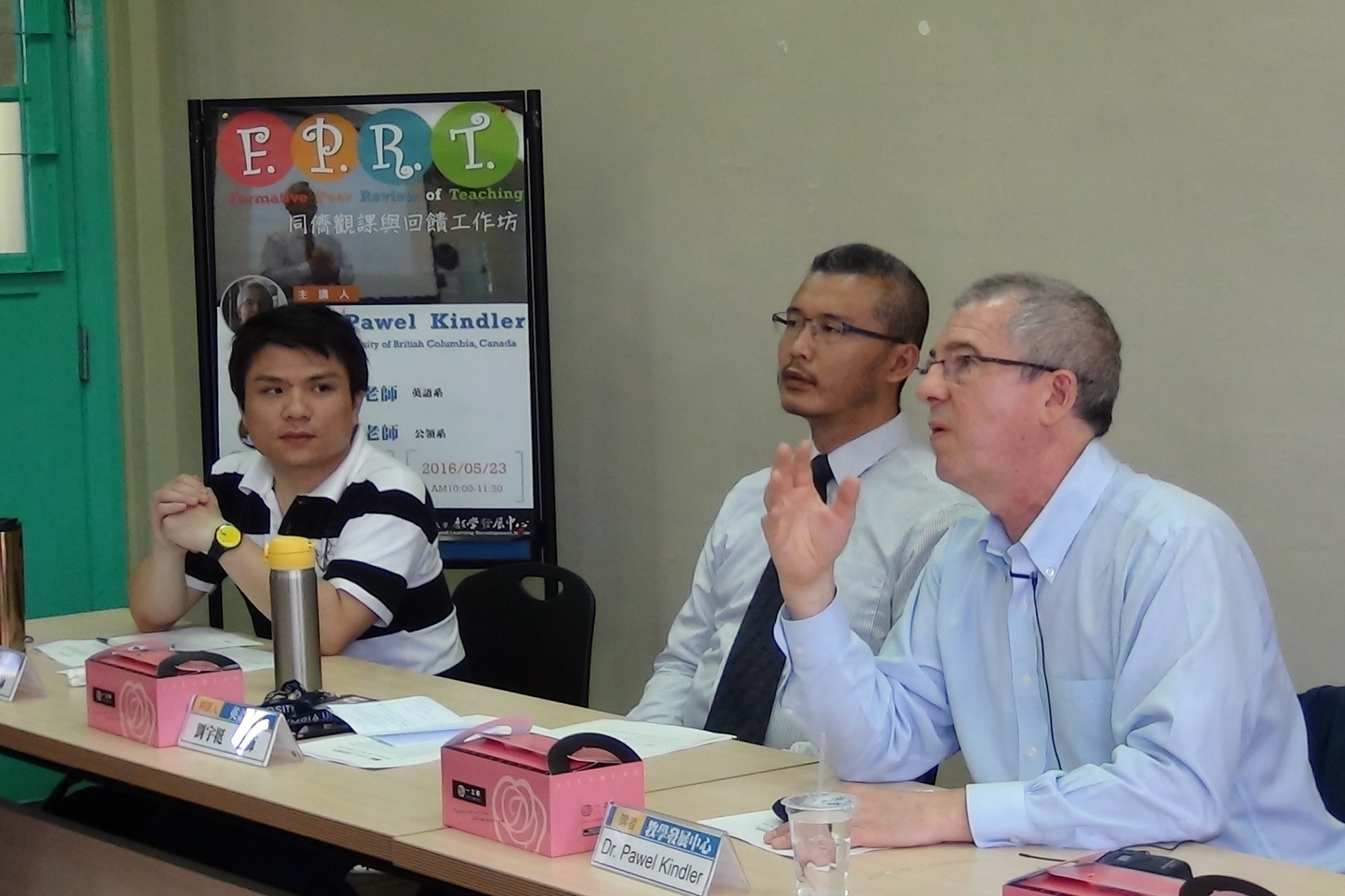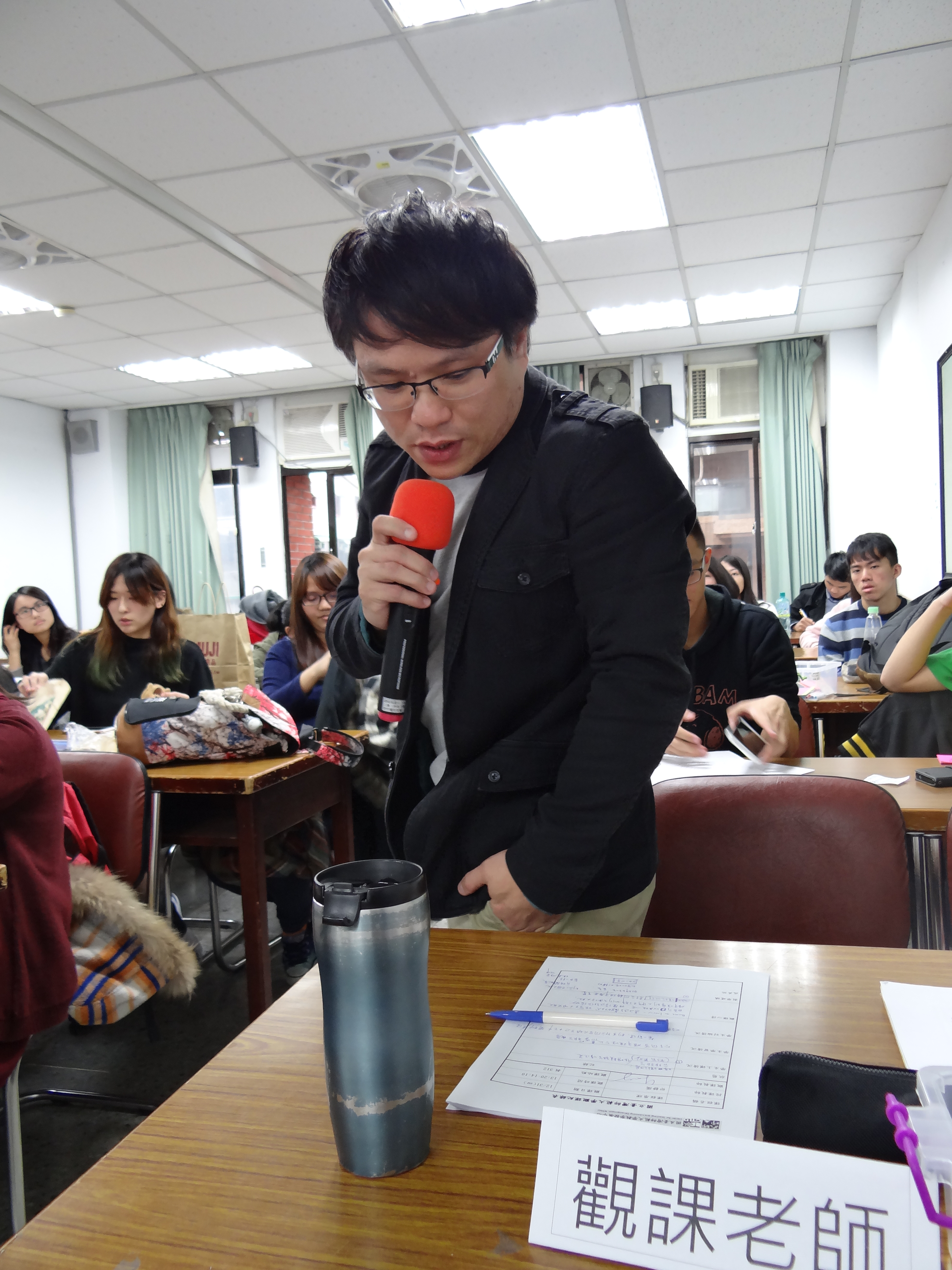- 首頁
- 教學發展
- 同儕觀課與回饋-全校開放觀課
何謂同儕觀課與回饋?
「同儕觀課與回饋」(Peer Review and Feedback, PRF)是一種教學的反思與合作,實施目的在於協助教師增進教學品質,而終極目標則為 (1) 提升臺師大學生的學習品質 (2) 支援教師的專業發展和教學知能。教學諮詢教師在過程中觀察授課教師的教學方法、師生互動、教材呈現,並給予建設性及支持性的回饋,鼓勵教師教學的長處,同時提供精進教學的建議。


為什麼要推動同儕觀課與回饋?
近年來,全球皆非常關注學生的學習經驗及大學教育的效能,對於高等教育中制度性及規律性評鑑的重視程度也逐漸提升,課程意見調查的評量著重於學生端的評量,而透過教師間組成社群 ,構築跨領域的對話平台,出席彼此的課堂且提供觀課意見,不僅可以作為學生回饋以外的評量及教學發展渠道,也可有效運用大學教師專業領域的教育專業和判斷,提供教學回饋、肯定優良教學方式並為教學發展的方向提出建議,因此全球各地的研究型大學已陸續採用同儕觀課與回饋制度,分別從學生和教師同儕的觀點,平衡看待教師教學的專業。
同儕觀課與回饋的三大流程
同儕觀課與回饋包含三個階段:觀課前會議、實際入班觀課及觀課後會議。在觀課前會議時,授課教師可與教學諮詢教師分享課程綱要、教學方法,以及討論觀課的重點面向等,除了觀課後會議的口頭分享之外,也可以請教學諮詢教師提供書面報告,作為日後改進教學之參考。

觀課前會議
觀課前會議需討論的重點如下:
- 討論觀課的目的
- 思索觀課的重點及面向
- 確認觀課時間(哪一節課?何時召開觀課後會議?)
- 事先取得觀課課程之課綱、講義或作業等補充資料
- 討論觀課後回饋的形式(口頭或書面)
除此之外,觀課前會議可討論下列問題:
- 這一節課與整個課程的關聯為何?
- 這一節課學生的預期學習成效為何?
- 課程時間如何規劃?
- 學生有課前的作業嗎?
- 是否有特別需要回饋的面向或教學方式?
- 這堂課是否採用新的教學方法,或者是慣用的教學方式?
- 截至目前為止,是否有任何問題或想法?

實際入班觀課
研擬觀課表單以不同的方式呈現教學的面向,詳細描述各面向該有的例子,可供教學諮詢教師作為實際入班觀課的參考;這些標準並非唯一的規範,也不是用來一一勾選,由於學科屬性的不同,因此提供兩種型態的表單供選擇。

觀課後會議
建議在實際入班觀課後的一週內舉行。 教學諮詢教師可參考下列的回饋技巧:
- 口頭回饋時應奠基於實際觀察到的行為和教學方法
- 先給予正面的口頭回饋
- 給予具體的回饋,授課教師可於日後運用並精進教學
- 若授課教師提出要求,可於觀課後提供書面報告
觀課後會議可討論下列問題:
- 這次的教學是否達成所有的課程目標?
- 這次教學的優點何在?
- 教學的挑戰何在?
- 下次教學是否有想要改變的地方?

資料來源:
- Policy on Peer Review of Teaching, Department of Cellular and Physiological Sciences, university of British Columbia, Vancouver, Canada
- http://artsfoa.sites.olt.ubc.ca/files/2012/09/Faculty-of-Arts-Peer-Review-of-Teaching-Guide-May-20131.pdf
- http://www.cte.cornell.edu/documents/Peer%20Review%20of%20Teaching%20-%20Guidelines.pdf
What is Peer Review and Feedback?
Peer Review and Feedback (PRF) is an important reflective and collaborative activity to assist faculty members in their efforts to improve the quality of their teaching. The ultimate goals of PRF are to: (1) improve the overall quality of student learning at NTNU and (2) facilitate and support the professional development and competency of NTNU teachers. Over the course of the review, peer reviewers observe the instructor’s (reviewee) teaching methods, his/her interactions with students, and the use and presentation of teaching materials. Following, constructive and supportive feedback is offered that acknowledges the reviewee’s strengths and provides suggestions for improvement.
Why Peer Review and Feedback?
Over the last few years, much focus has been given to the learning experience of students and the effectiveness of university education. At the same time, the importance of the role of systematic and regular assessment in the sphere of higher education has continued to grow. While course evaluation surveys emphasize student assessment, also important is the social connectivity among faculty that helps form inter-disciplinary platforms beneficial for dialogue. Sitting in on the class of academic colleagues and offering class observations not only serves as a channel for teaching assessment and development outside of student feedback, but also makes effective use of the educational expertise and professional judgment of university faculty in providing pedagogical feedback, recognizing and affirming excellent teaching methods, and offering suggestions for further development. Therefore, in large research universities worldwide, a system of PRF is being used to offer a balanced view of the teaching profession by including the perspectives of both students and teachers.
The Three Stages of Peer Review and Feedback
Peer Review and Feedback has three major stages: A pre-observation meeting, classroom observation, and a post-observation meeting. During the pre-observation meeting, the reviewee may discuss with his/her peer reviewer the course curriculum, teaching methods, and any specific areas on which he/she wishes to receive feedback. In the post-observation meeting, in addition to feedback discussed, the reviewee may also ask his/her peer reviewer to produce a written report to serve as future reference.
Pre-observation Meeting
In the pre-observation meeting the following topics should be discussed:
- A discussion of the goals for the classroom observation
- Thinking about the focus and direction of the classroom observation
- Confirming the time of the classroom observation (Which class period? When to convene the post-observation meeting?)
- Obtaining course curriculum, lecture handouts, prior homework, and any other supplementary information relevant to the class
- Discussing the form that the post-observation meeting should take (face-to-face discussion or written report)
In addition, the following questions may be addressed in the pre-observation meeting:
- How does the class fit in with the overall curriculum?
- What is the expected learning outcome for students of the class?
- How are class times planned?
- Did students have homework prior to the class?
- Are there specific areas or teaching methods that require feedback?
- Are new teaching methods going to be used in class? Or will previous teaching methods be employed?
- At this point are there any other questions or ideas that need to be addressed?
Classroom Observation
Two forms are available for download. Each form highlights various aspects of instruction differently, while both offer detailed explanations of each aspect of instruction. These forms can be used as a reference by the peer reviewer over the course of the classroom observation. Please note that the criterion listed in the forms is not exhaustive and not without other options. Neither is it necessary to refer to every aspect listed. As academic disciples vary in content, we offer two types of forms to choose from.
Post-observation Meeting
It is recommended that the post-observation meeting be held within a week following the classroom observation. The peer reviewer may refer to the following suggestions when preparing to present his/her feedback:
- Feedback discussed with the reviewee should be based strictly on the behavior and teaching methods observed during the period of classroom observation.
- First offer positive feedback.
- Offer concrete feedback that can be used by the reviewee to improve in the future.
- If requested by the reviewee, a written report may be produced by the peer reviewer.
Topics that may be discussed in the post-observation meeting include:
- Did the instruction meet all class goals?
- What were the strong points of the instruction?
- What the challenging areas of the instruction?
- Are there areas of the instruction that you would like to see changed?
